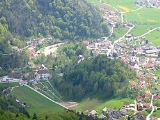
Polhov Gradec
Encyclopedia
Polhov Gradec is a settlement in the Municipality of Dobrova-Polhov Gradec
in the Upper Carniola
region of Slovenia
. It is the center of the Upper Gradaščica
Valley. The area has been inhabited since Roman
times and a Roman villa
has been excavated near the town, finds from which are kept in the National Museum of Slovenia
.
There is a large eighteenth-century mansion
in the settlement. It houses the local museum. The parish church
in the town is dedicated to Birth of Mary
. It is mentioned as an independent parish in documents dating to 1292. It originally belonged to the Patriarchate of Aquileia and since 1461 it has been part of the Archdiocese of Ljubljana
. The actual church building dates to 1736, after the old church burned in 1728 and had to be completely demolished. It was extensively renovated in 2000.
Dobrova-Polhov Gradec
Dobrova - Polhov Gradec a municipality in Slovenia. The main settlements in the municipality are Dobrova and Polhov Gradec.-External links:*...
in the Upper Carniola
Upper Carniola
Upper Carniola is a traditional region of Slovenia, the northern mountainous part of the larger Carniola region. The centre of the region is Kranj, while other urban centers include Jesenice, Tržič, Škofja Loka, Kamnik, and Domžale.- Historical background :...
region of Slovenia
Slovenia
Slovenia , officially the Republic of Slovenia , is a country in Central and Southeastern Europe touching the Alps and bordering the Mediterranean. Slovenia borders Italy to the west, Croatia to the south and east, Hungary to the northeast, and Austria to the north, and also has a small portion of...
. It is the center of the Upper Gradaščica
Gradašcica
-References:...
Valley. The area has been inhabited since Roman
Ancient Rome
Ancient Rome was a thriving civilization that grew on the Italian Peninsula as early as the 8th century BC. Located along the Mediterranean Sea and centered on the city of Rome, it expanded to one of the largest empires in the ancient world....
times and a Roman villa
Villa rustica
Villa rustica was the term used by the ancient Romans to denote a villa set in the open countryside, often as the hub of a large agricultural estate . The adjective rusticum was used to distinguish it from an urban or resort villa...
has been excavated near the town, finds from which are kept in the National Museum of Slovenia
National Museum of Slovenia
The National Museum of Slovenia is located in Ljubljana, the capital of Slovenia. It is situated in the Center district of the city near the Tivoli Park....
.
There is a large eighteenth-century mansion
Mansion
A mansion is a very large dwelling house. U.S. real estate brokers define a mansion as a dwelling of over . A traditional European mansion was defined as a house which contained a ballroom and tens of bedrooms...
in the settlement. It houses the local museum. The parish church
Parish church
A parish church , in Christianity, is the church which acts as the religious centre of a parish, the basic administrative unit of episcopal churches....
in the town is dedicated to Birth of Mary
Nativity of Mary
The Nativity of Mary, or Birth of the Virgin and various permutations, is celebrated as a liturgical feast in the Roman Catholic calendar of saints and in most Anglican liturgical calendars on 8 September, nine months after the solemnity of her Immaculate Conception, celebrated on 8 December...
. It is mentioned as an independent parish in documents dating to 1292. It originally belonged to the Patriarchate of Aquileia and since 1461 it has been part of the Archdiocese of Ljubljana
Roman Catholic Archdiocese of Ljubljana
The Roman Catholic Metropolitan Archdiocese of Ljubljana is an ecclesiastical territory or diocese of the Roman Catholic Church in Slovenia. It was erected as the Diocese of Ljubljana by Pope Eugene IV on 6 December 1461 and was immediately subject to the Holy See from its creation until erected...
. The actual church building dates to 1736, after the old church burned in 1728 and had to be completely demolished. It was extensively renovated in 2000.

